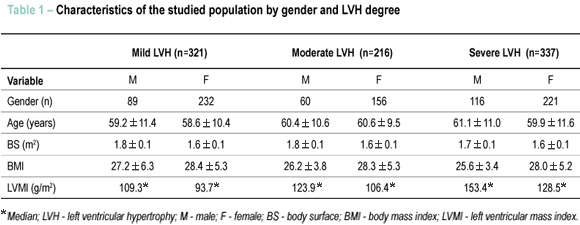BACKGROUND: Several factors are known to interfere with electrocardiogram (ECG) sensitivity when diagnosing Left Ventricular Hypertrophy (LVH), with gender and cardiac mass being two of the most important ones OBJECTIVE: To evaluate the influence of gender on the sensitivity of some of the criteria used to detect LVH, according to the progression of ventricular hypertrophy degree. METHODS: According to gender and the degree of LVH at the echocardiogram, the patients were divided in three groups: mild, moderate and severe LVH. ECG sensitivity to detect LVH was assessed between men and women, according to the LVH degree. RESULTS: Of the 874 patients, 265 were males (30.3%) and 609, females (69.7%). The [(S + R) X QRS], Sokolow-Lyon, Romhilt-Estes, Perugia and strain criteria showed high discriminatory power in the diagnosis of LVH between men and women in the three groups with LVH, with a superior performance in the male population and highlighting the importance of the [(S + R) X QRS] and Perugia scores. Conclusion: The diagnostic sensitivity of the ECG increases with the cardiac mass. The examination is more sensitive in men, highlighting the importance of the [(S + R) X QRS] and Perugia scores. CONCLUSION: The diagnostic sensitivity of the ECG increases with the cardiac mass. The examination is more sensitive in men, highlighting the importance of the [(S + R) X QRS] and Perugia scores.
Electrocardiography; hypertrophy, left ventricular; hypertension; heart failure; gender identify




